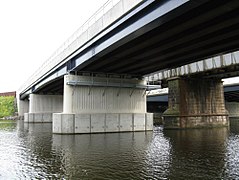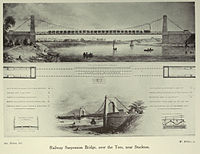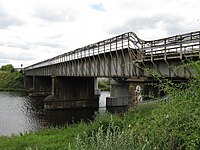Surtees Rail Bridge
| Surtees Rail Bridge | |
| County Durham, Yorkshire | |
|---|---|
 Surtees Rail Bridge over the River Tees | |
| Location | |
| Carrying: | Rail traffic |
| Crossing: | River Tees |
| Location | |
| Grid reference: | NZ44671795 |
| Location: | 54°33’17"N, 1°18’39"W |
| Structure | |
| Material: | Reinforced concrete and steel plate girder |
| History | |
| Built =2009 | |
| Information | |
| Owned by: | Network Rail |
The Surtees Rail Bridge is a rail bridge carrying the Tees Valley Line over the River Tees, between the North Riding of Yorkshire on the south bank and County Durham on the north bank. The bridge is to be found south of Stockton-on-Tees town centre and just north of the adjacent Surtees Bridge which carries the A66 road.
The bridge is built on the site of a series of Tees Bridges alternating between two adjacent crossing sites.
Previous rail bridges in Stockton-on-Tees
Since 1830 there have been a series of railway bridges over the River Tees at this point. To ensure continuity of service, replacement bridges have been constructed adjacent to the current operational bridge.
The 1830 Stockton Railway Bridge
The 1830 bridge was an iron chain suspension bridge built principally to carry coal on the Stockton and Darlington Railway to Port Darlington, later to be renamed Middlesbrough, and was to be the first suspension bridge built for railway traffic.[1]

The designer was Sir Samuel Brown, a retired naval officer with experience building the 1820 Union Bridge over the River Tweed and the Royal Suspension Chain Pier in Brighton (1823). The bridge was 412 feet long with a main span of 218 feet.[1] It had an unstiffened bridge deck 6 feet wide which was suspended using round eye bar link chain supported by two masonry towers.
When the first trial steam engine and train of loaded coal wagons crossed the bridge on 27 December 1830, the bridge flexed so much that the unstiffened bridge deck rose like a static wave in front of the engine. One particular trial load was enough to damage the towers with one tower on the Yorkshire side cracking. The bridge was propped mid span using trestles and traffic was restricted to four wagons at a time, spaced 27 feet apart by chains to spread the load.[1] After this experience, there are to this day no rail suspension bridges in the United Kingdom.[1]
The foundations and submerged remains of the wooden trestles of the 1830 bridge were found during work for the construction of the 2009 Surtees Rail Bridge.
The 1844 Stockton Railway Bridge
The 1830 bridge was inadequate and a replacement was built between 1841 and 1844 to the design of Robert Stephenson, as a five span cast iron trussed girder bridge on piled masonry piers.[1]
The bridge was similar in design to Stephenson's 1846 bridge over the River Dee in Chester that had collapsed in the year following its completion. To ensure the same thing did not happen at Stockton, props were added. The bridge carried rail traffic until succeeded by the 1881 wrought iron bridge.[1]

The 1881 bridge
In 1881 a wrought iron bridge was constructed with five spans of plate girders supported on concrete-filled iron cylinders.[1] When the bridge was superseded by the 1906 bridge the tracks were removed, but the bridge was only dismantled in 2008-2009, to make way for the 2009 Surtees Rail Bridge.

The 1906 Tees Bridge
In 1906 a new superstructure was built on the original masonry piers of the 1844 Stephenson bridge using steel plate girders instead of the previous cast iron girders and brought back into use.[1]
The downstream 1881 wrought iron bridge was closed and the tracks removed.[1] Due to settlement of the embankment and bridge distress there was a speed restriction imposed on the 1906 bridge.[2]
Although no longer carrying rail traffic, the bridge continues to carry rail signalling cables across the River Tees.
The 2009 Surtees Rail Bridge
In 2008-2009, the 1881 bridge was demolished to build a three span steel and concrete railway bridge. The new bridge was designed by HBPW Structural and Civil Engineering Services and built by Carillion Civil Engineering and Railtrack.
The bridge's piers were designed to align with the middle three piers of the existing 1906 Tees Bridge to allow for the easy passage of river traffic.
Outside links
| ("Wikimedia Commons" has material about Surtees Rail Bridge) |
- Surtees Rail Bridge: Bridges on the Tyne
References
- ↑ 1.0 1.1 1.2 1.3 1.4 1.5 1.6 1.7 1.8 "Stockton Railway Bridge (1830), site of". Engineering Timelines. http://www.engineering-timelines.com/scripts/engineeringItem.asp?id=1135. Retrieved 18 February 2012.
- ↑ Jones, C.A.; Stewart, D.I.; Danilewicz, C.J. (April 2008). "Bridge Distress Caused by Approach Embankment Settlement" (PDF). Geotechnical Engineering 161 (GE2): 63–74. http://eprints.whiterose.ac.uk/4769/1/Bridge_distress_caused_by_approach_embankment_settlement.pdf. Retrieved 18 January 2010.
| Bridges and crossings on the River Tees | ||||||
|---|---|---|---|---|---|---|
| Preston Pipe Bridge | Jubilee Bridge | Surtees Bridge | Surtees Rail Bridge | Victoria Bridge | Millennium Footbridge | Princess of Wales Bridge |
